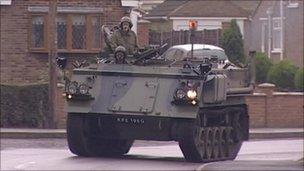Retired military icons: The ultimate boys' toys?
- Published
Shaun Mitchell explains why he likes to buy and restore old tanks, which he drives around the streets of Norfolk
A number of military icons, including the Harrier jump jet, are being forced into retirement by government spending cuts.
But for a small army of dealers and enthusiasts, this presents a unique opportunity to buy their very own piece of history.
A tabby cat scampers away as the powerful Jaguar engine growls into life.
The Sabre - one of the fastest tracked vehicles ever operated by the British Army - inches tortuously around a back yard little bigger than it is.
At the controls, his head poking out of a small hatch underneath the turret, Shaun Mitchell watches anxiously for plant pots.
"What else would you put in your garden?" he grins, "Flowers?"
Tanks for sale?
Shaun is one of a small bunch of enthusiasts who buy and restore military vehicles.
Starting with a 4x4 when he was 18, he now owns a World War II lorry, a Ferret scout car, a half-share in an armoured personnel carrier and an anti-aircraft gun - as well as the Sabre.
Most of them are stored behind his cottage in West Lynn, Norfolk.
"Unlike classic cars, every military vehicle is completely different to work on. And you get a lot more for your money," he says.
There may soon be more vehicles for Shaun and others to get their hands on.
In October's Strategic Defence Review, it was announced that spending on the military would decrease by 8% over four years. Among the cuts: the entire Harrier fleet and 40% of the Army's tanks.
Where they will end up will be decided in large part by the Disposal Services Authority (DSA), the body responsible for selling equipment the military no longer wants.
Since 1993, it has raised £900m for the Ministry of Defence from sales of everything from destroyers to water bottles.

Shaun co-owns an armoured personnel carrier as well as a tank and an anti-aircraft gun
Most of this was raised from large sales to foreign forces, but when there is no interest abroad, the DSA turns to dealers in the UK.
This year, it expects to raise a further £45m, with £6m from smaller vehicles. However, this is a fraction of the £6.5bn the Ministry of Defence spent on new equipment last year alone.
This depreciation keeps vehicle dealers like Marcus Glenn, from Lincolnshire, in business and is one of the attractions for collectors.
"For a few thousand pounds, you can pick up something that once cost half a million," he says.
Prices vary according to the vehicle, but an Alvis FV432 armoured personnel carrier can be bought for £3,000, while an Abbot self-propelled gun costs around £15,000 - although prices for vehicles in mint condition are considerably higher.
Marcus says anyone can own an ex-military vehicle.
"Four friends can buy an old tank and drive it around some waste ground on the weekend - it's the ultimate boy's toy."
Their weapons deactivated and sensitive equipment removed, there are no restrictions on buying vehicles, and with a tracked vehicle licence, tanks can also be driven on the road.
Though with a fuel consumption of just one to four miles per gallon, that thrill won't come cheap.
'Fast and flashy'
That's not an issue with the vehicle that Chris Wilson, of Jet Art Aviation, is selling.
Perched high on a hillside near Halifax, West Yorkshire, a Harrier gleams in the winter sunshine. Even without its engine and with its weapons deactivated, it is an impressive sight.

A Harrier was recently put up for sale on eBay but later removed
It was also an unusual sight on auction website eBay, where bidding had passed £90,000 before administrators removed it, saying it contravened their weapons policy.
"They called it a 'weapons delivery system'," Chris says. "It couldn't deliver a pizza now."
Chris, ex-RAF ground crew, started dealing in aircraft memorabilia, before graduating to larger items like jet nose cones and ejector seats, and finally, whole planes. It has become a full-time job.
His seventh Harrier has taken a year to restore, after being bought as a hulk from a museum. It will probably become a businessman's trophy.
"It's fast, it's flashy… if they've got a Harrier jump jet on the lawn, it's cool," he says.
Few of the engineers and airman who worked on the machine - once the cutting edge of technology and the pride of the forces - would surely have predicted its second life - as a garden ornament.
- Published11 February 2011
- Published20 October 2010
- Published19 October 2010